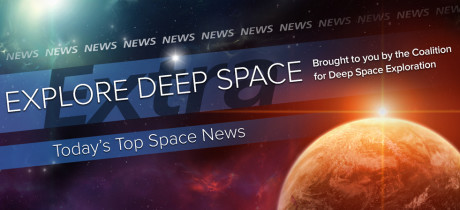In Today’s Deep Space Extra… Two NASA astronauts and a Russian cosmonaut launched and docked to the International Space Station (ISS) late Thursday, returning the orbiting science to six person operations for the first time since December. NASA Administrator Jim Bridenstine’s remarks this week about the possible exchange of the SLS for a commercial launch of Exploration Mission-1 (EM-1) continues to cause a stir.
Human Space Exploration
Bridenstine reiterates commitment to SLS
SpaceNews.com (3/14): NASA Administrator Jim Bridenstine sought to erase doubts over his commitment to the Space Launch System (SLS) during remarks Thursday in Washington before a Space Transportation Association luncheon. The remarks followed by a day his testimony before the U.S. Senate Commerce Committee in which Bridenstine said the agency was considering a commercial launch alternative to the SLS for Exploration Mission 1 (EM-1). EM-1 is to mate Orion and the SLS together for the first time for a multi week test flight around the Moon and back to Earth. His statements to lawmakers were prompted by a potential delay in the EM-1 launch beyond June 2020 with the SLS.
Spacepolicyonline.com (3/14): NASA astronaut Nick Hague and Russian cosmonaut Aleksey Ovchinin arrived at the International Space Station (ISS) today, five months later than planned. Along with NASA astronaut Christina Koch, their Soyuz MS-12 spacecraft docked at ISS at 9:01 pm ET approximately 6 hours after lift off from the Baikonur Cosmodrome. The uneventful trip was quite unlike their first launch on October 11 which ended abruptly after a launch failure. After they docked, NASA and Roscosmos officials confirmed that mixed U.S.-Russian crews will continue to fly on Soyuz and on the new U.S. commercial crew systems once they are operational.
Space Station crew back at six with successful Soyuz docking
CBS News via Spaceflightnow.com (3/15): Russia’s Soyuz MS-12 spacecraft with NASA astronauts Nick Hague and Christina Koch and cosmonaut Alexey Ovchinin launched and docked with the International Space Station late Thursday returning operations aboard the orbiting science lab to six persons for the first time since December. The newcomers docked at 9:01 p.m., EDT, about six hours after lifting off from Kazakhstan. They were greeted by Space Station Expedition 58 commander Oleg Kononenko, NASA’s Anne McClain and Canadian Space Agency astronaut David Saint-Jacques. The trek also marked personal victories for Hague and Ovchinin, whose October 11 Soyuz launch to the Space Station was aborted two minutes into flight. Their Soyuz capsule descended safely back to Earth in Kazakhstan. The incident was attributed to pre-launch damage to one of four first stage boosters, which struck the rocket with the two men as it fell away after jettison.
Space Science
Chang’e-4 spacecraft enter third lunar night, Yutu-2 reaches design lifetime
SpaceNews.com (3/14): China’s Chang-e 4 lunar lander and rover touched down on the Moon’s far side in early January, a space first. This week, they powered down for a third lengthy lunar night. The Yutu-2 rover has so far logged 163 meters traveled. The Chang-e 4 hardware is in good shape and lander and rover explorations are to continue.
Opportunity rover captured beautiful panoramic images before being felled by dust storm
Spaceflightnisider.com (3/14): A major Martian storm is blamed for ending NASA’s long running Opportunity rover mission on the Red Planet. Plans for a 90 day mission as Opportunity landed in January 2004 stretched to June 2018. NASA ended efforts to re-establish contact earlier this year, but not before unveiling some of the rover’s end of mission panoramic imagery.
New ring of dust discovered in the inner solar system
Universe Today (3/14): Two studies assess the presence of ancient dust in the inner solar system, debris noted in the modern era that may have been left over from early planet formation.
Cooking up alien atmospheres on Earth
NASA Jet Propulsion Laboratory (3/14): Scientists at NASA’s Jet Propulsion Laboratory (JPL) have devised a means of simulating what the atmosphere might be like on a “hot Jupiter,” a special class of large extra solar planets, or “gas giants” that orbit close to their stars, completing a single circuit in just days.
Other News
Trump’s DOD space reorganization moves forward, but headwinds await
Spacepolicyonline.com (3/13): Congressional oversight panels indicate this week that the Trump Administration’s plans to establish a Space Force as a sixth branch of the U.S. military as part of the U.S. Air Force will continue to face some headwinds.
Griffin: Space Development Agency to bring new capabilities that don’t exist today
SpaceNews.com (3/14): The idea of a Space Development Agency first entered the conversation last summer as Pentagon officials were trying to figure out how to respond to Congress’ questions about how the Defense Department planned to manage space. It took months of legal reviews and lots of red tape to create a new agency, and “we reached the end of that yesterday,” Undersecretary of Defense for Research and Engineering Mike Griffin said on Wednesday during a meeting with reporters at the Pentagon.

